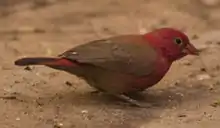Firefinch
The firefinches form a genus, Lagonosticta, of small seed-eating African birds in the family Estrildidae.
| Firefinches | |
|---|---|
 | |
| Red-billed firefinch (Lagonosticta senegala) | |
| Scientific classification | |
| Domain: | Eukaryota |
| Kingdom: | Animalia |
| Phylum: | Chordata |
| Clade: | Dinosauria |
| Class: | Aves |
| Order: | Passeriformes |
| Family: | Estrildidae |
| Subfamily: | Estrildidae |
| Genus: | Lagonosticta Cabanis, 1851 |
| Type species | |
| Fringilla rubricata[1] M.H.C. Lichtenstein, 1823 | |
| Species | |
|
11, see text | |
The genus was introduced by the German ornithologists Jean Cabanis in 1851.[2] The type species was subsequently designated as the African firefinch.[3] The name combines the Ancient Greek words lagōn "flank" and stiktos "spotted".[4] The genus Lagonosticta is sister to the brown twinspot which is placed in its own genus Clytospiza.[5]
Species
The genus contains 10 species:[6]
| Image | Common Name | Scientific name | Distribution |
|---|---|---|---|
_male.jpg.webp) | Red-billed firefinch | Lagonosticta senegala | Democratic Republic of the Congo, Uganda, Kenya, Angola, Zambia, Mozambique, South Africa, Malawi, Nigeria, Senegal, Gambia, Cameroon, Chad, Sudan, Eritrea and Ethiopia |
 | African firefinch | Lagonosticta rubricata | Senegal east to Ethiopia then south to the Democratic Republic of Congo and Tanzania south through Mozambique to the Eastern Cape province of South Africa. |
.jpg.webp) | Jameson's firefinch | Lagonosticta rhodopareia | Angola, Botswana, Chad, The Democratic Republic of the Congo, Eritrea, Eswatini, Ethiopia, Kenya, Malawi, Mali, Mozambique, Namibia, South Africa, South Sudan, Tanzania, Uganda, Zambia and Zimbabwe |
| Mali firefinch | Lagonosticta virata | Western Africa | |
%252C_crop.jpg.webp) | Rock firefinch | Lagonosticta sanguinodorsalis | central Nigeria |
.jpg.webp) | Chad firefinch | Lagonosticta umbrinodorsalis | southwest Chad where it is fairly common and northeast Cameroon |
 | Black-bellied firefinch | Lagonosticta rara | Benin, Burkina Faso, Cameroon, Central African Republic, Chad, The Democratic Republic of the Congo, Côte d'Ivoire, Ghana, Guinea, Kenya, Liberia, Nigeria, Senegal, Sierra Leone, South Sudan, Togo and Uganda |
.jpg.webp) | Bar-breasted firefinch | Lagonosticta rufopicta | Gambia and southern Senegal east to western Uganda and eastern Kenya |
.jpg.webp) | Brown firefinch | Lagonosticta nitidula | Angola, The Democratic Republic of the Congo, Zambia, southern Tanzania and northern areas of Namibia, Botswana and Zimbabwe |
 | Black-faced firefinch | Lagonosticta larvata | Benin, Burkina Faso, Cameroon, Central African Republic, Chad, The Democratic Republic of the Congo, Côte d'Ivoire, Ethiopia, Gambia, Ghana, Guinea-Bissau, Mali, Niger, Nigeria, Senegal, Sierra Leone, Sudan, Togo and Uganda |
References
- "Estrildidae". aviansystematics.org. The Trust for Avian Systematics. Retrieved 2023-07-16.
- Cabanis, Jean; Heine, Ferdinand (1860). Museum Heineanum : Verzeichniss der ornithologischen Sammlung des Oberamtmann Ferdinand Heine, auf Gut St. Burchard vor Halberstadt (in German and Latin). Vol. 1. Halberstadt: R. Frantz. p. 171.
- Paynter, Raymond A. Jr, ed. (1968). Check-list of birds of the world. Vol. 14. Cambridge, Massachusetts: Museum of Comparative Zoology. p. 325.
- Jobling, James A. (2010). The Helm Dictionary of Scientific Bird Names. London: Christopher Helm. p. 217. ISBN 978-1-4081-2501-4.
- Olsson, Urban; Alström, Per (2020). "A comprehensive phylogeny and taxonomic evaluation of the waxbills (Aves: Estrildidae)". Molecular Phylogenetics and Evolution. 146: 106757. doi:10.1016/j.ympev.2020.106757.
- Gill, Frank; Donsker, David; Rasmussen, Pamela, eds. (January 2023). "Waxbills, parrotfinches, munias, whydahs, Olive Warbler, accentors, pipits". IOC World Bird List Version 13.1. International Ornithologists' Union. Retrieved 10 February 2023.
This article is issued from Wikipedia. The text is licensed under Creative Commons - Attribution - Sharealike. Additional terms may apply for the media files.